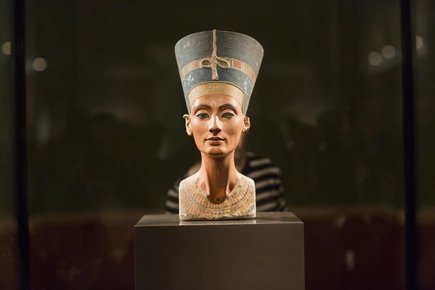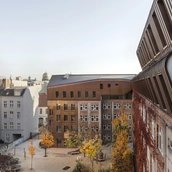
Marzahn's original cell around Helene-Weigel-Platz
In March 1975, construction vehicles begin to plough up the earth in the hitherto tranquil fields around the small village of Biesdorf. In Marzahn - which of course did not have a name at that time - the development work for the construction of the large housing estate begins.
At the VIII party congress of the SED in 1971 it was decided to solve the "housing question as a social problem until 1990". In this context, the planners defined the new development area Berlin-Marzahn. The planned new residential buildings will be built in several sections from south to north until the late 1980s. Each of the eleven-storey prefabricated buildings is assembled from prefabricated large panels in just 110 days. Therefore, the topping-out ceremony for the first newly built residential building in Marchwitzastrasse 41-45 was held as early as 1977. The first tenants move in at the end of 1977.
As you can see, the pace has been rapid from the very beginning: between December 1978 and January 1979 alone, 15,000 "new Marzahn residents" move into their apartments in the first residential area. In the Marzahn I residential area, still known today as the Marzahn I residential area in the vicinity of the small Springpfuhls, more than 4,000 apartments were built by the end of 1978, when the "new city" faced major challenges. Which city triples its population within 10 years? Especially young families move to Berlin-Marzahn. Marzahn quickly developed into Berlin's district with the largest number of children. Cranes were spinning everywhere, while the removal vans were already making their way through the muddy desert. In this so-called "rubber boot era" - the name comes from the fact that all first-time buyers always deposited rubber boots at the stations and stops to protect their good city shoes - it is necessary to set up an infrastructure in the shortest possible time, indeed to literally build it up from the ground. Temporaries were the order of the day at that time, but the district was gradually becoming greener and more homely. Thousands of Marzahner plant the areas between the houses and streets themselves with trees and flowers.
This original cell of the large housing estate, which extended beyond the city limits until the end of the 1980s with hundreds of thousands of apartments, is still intact today and clearly reflects the utopia of the time. Its symbol is the large guide crown created by the sculptor Alfred Bernau. In front of house number 68 - between two ten floors at the level of Marchwitzastrasse - stands this ten-metre-high concrete sculpture as a memorial to the completion of the first houses in the new Marzahn district. Right next to it is the beautiful copper relief in honour of the space flight of the Soviet cosmonaut Valeri Bykowski and the German research cosmonaut Sigmund Jähn (1st German in space) with the spaceship Soyuz 31.The great main road was renamed Allee der Kosmonauten in 1978 in the presence of the two astronauts. On the other side of the road around Helene-Weigel-Platz, which the "natives" referred to as ADK for short, there are still people from that time:
- the Medical Service Center of 1979
- the 1981 "Sojus" cinema
- the S-Bahn station of 1982
- the indoor swimming pool from 1986
- and the town hall of 1989



